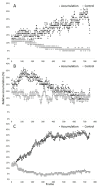Expanding the Limits of Computer-Assisted Sperm Analysis through the Development of Open Software
- PMID: 32764457
- PMCID: PMC7464510
- DOI: 10.3390/biology9080207
Expanding the Limits of Computer-Assisted Sperm Analysis through the Development of Open Software
Abstract
Computer assisted sperm analysis (CASA) systems can reduce errors occurring in manual analysis. However, commercial CASA systems are frequently not applicable at the forefront of challenging research endeavors. The development of open source software may offer important solutions for researchers working in related areas. Here, we present an example of this, with the development of three new modules for the OpenCASA software (hosted at Github). The first is the Chemotactic Sperm Accumulation Module, a powerful tool for studying sperm chemotactic behavior, analyzing the sperm accumulation in the direct vicinity of the stimuli. This module was validated by comparing fish sperm accumulation, with or without the influence of an attractant. The analysis clearly indicated cell accumulation in the treatment group, while the distribution of sperm was random in the control group. The second is the Sperm Functionality Module, based on the ability to recognize five sperm subpopulations according to their fluorescence patterns associated with the plasma membrane and acrosomal status. The last module is the Sperm Concentration Module, which expands the utilities of OpenCASA. These last two modules were validated, using bull sperm, by comparing them with visual counting by an observer. A high level of correlation was achieved in almost all the data, and a good agreement between both methods was obtained. With these newly developed modules, OpenCASA is consolidated as a powerful free and open-source tool that allows different aspects of sperm quality to be evaluated, with many potential applications for researchers.
Keywords: computer-aided sperm analysis; open-source software; sperm chemotaxis; sperm concentration; sperm function; sperm quality.
Conflict of interest statement
The authors declare no conflict of interest. The funders had no role in the design of the study; in the collection, analyses, or interpretation of data; in the writing of the manuscript, or in the decision to publish the results.
Figures






References
-
- Baker H.W., Clarke G.N. Sperm morphology: Consistency of assessment of the same sperm by different observers. Clin. Reprod. Fertil. 1987;5:37–43. - PubMed
Grants and funding
LinkOut - more resources
Full Text Sources

